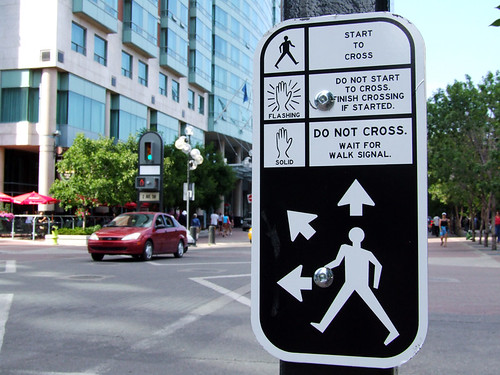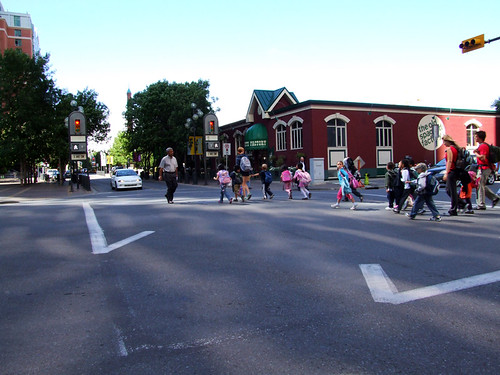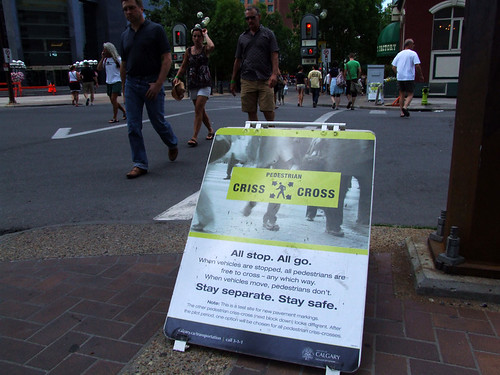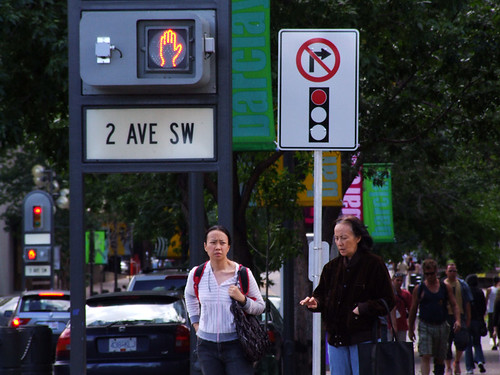Cross-posted from Spacing Montreal
CALGARY — I’m in Calgary at the moment, en route to Hong Kong, where I will be doing a master’s degree for the next couple of years. This is a fast-growing, fast-changing city, and there are a couple of interesting changes that I noticed while I was here. One of them is the introduction of two new scramble crossings in the Eau Claire neighbourhood of the city’s downtown area.
Often associated with Tokyo’s famous Shibuya Crossing, scramble crossings are in fact a North American invention, originating in Kansas City and Vancouver in the 1940s.
Scramble crossings disappeared in North America for several decades, victims of the postwar dominance of the automobile. Attitudes have changed, though, and the crossings are making a comeback. In 2003, Montreal installed them without much fanfare in the Quartier international, at such corners as McGill and St. Jacques and Viger and St. Urbain; they can also be found at several other intersections, like Monkland and Girouard in NDG. There is nothing to indicate that pedestrians are allowed to cross in all directions — some figure it out but others seem hesitant to cross diagonally.
In Calgary, by contrast, the city has made a big deal of its new pedestrian scrambles, accompanying their installation with plenty of instructional signage. Painted lines in the intersection let pedestrians know that it’s okay to cross diagonally. Based on what I’ve seen, it doesn’t take long for people to grasp the concept, and with each light cycle there are people who cross in all directions. Prominent signs prohibit drivers from making right turns on red.
In Toronto, city officials are on the verge of turning the intersection of Yonge and Dundas, one of the city’s busiest, into a scramble crossing. Some commenters on Spacing Toronto worried that it would used as a way to increase the amount of time vehicles have to pass through the intersection, thereby increasing the time pedestrians have to wait to cross, but this strikes me as a bit paranoid — the advantages of having an exclusive pedestrian phase at a busy corner outweight any disadvantages that come from having to wait a few seconds longer for cars to pass.
Where Montreal is concerned, however, a more legitimate problem would be the issue of jaywalkers. Whereas Calgarians hardly ever jaywalk, refusing to cross against the light even when no cars are coming, Montrealers aren’t nearly so patient. They would likely take advantage of the green light for cars to cross outside of the pedestrian phase of the light cycle, which could be dangerous if motorists aren’t paying attention.






7 comments
It’s not paranoid, it’s a legitimate concern. If pedestrians are only allowed to cross with the scramble phase, the timing could easily favor cars.
I’ve encountered these crossings before in other cities, and it’s really not that big a deal.
I have to agree with “person man”, I think it is a legitimate concern.
I applaud the city for experimenting with ideas aimed at improving the pedestrian realm… but I’m skeptical with this particular design. As “Stuart” pointed out in the October post, I imagine pedestrians will have to wait through two signals now. Understandably, pedestrians really don’t like waiting – an industry rule-of-thumb is that “noncompliance” is very likely when peds have to wait more than 30 seconds. From my experience with these signals in Sà £o Paulo (where they are at every intersection), many people risk crossing on a red (particularly those who just want to cross in one direction) and the rest stuck waiting so long get frustrated. The thing is, the signal timing in Sà £o Paulo is brutally in favour of automobiles. I think signal timing can make or break this scramble intersections, so it will be very interesting to see how this one plays out. I think there are better and even cheaper ways to guarantee improvements to the pedestrian realm…
A scramble at Yonge-Eglinton would improve matters for cars even with no increase in total car time, because it’s almost impossible to turn right because of the volume of pedestrians crossing in front on a red or to the right on a green.
I live in Calgary.
The two intersections where they’re being tried aren’t very busy intersections – lots of pedestrians midday, but not too much traffic on either street.
I go through both intersections a number of times each day on foot and bike and pedestrian non-compliance hasn’t been an issue – the biggest thing I’ve seen is the huge number of drivers who ignore the “no turn on red” signs. The second and third photos really shows how non-prominent they are (one small sign at the side of the road).
The real test will be when they put them in at some major intersections in the middle of downtown where there’s more significant vehicle traffic.
Isn’t the Yonge-Dundas intersection a no-turn intersection to begin with? The sheer flow of pedestrians usually gives the driver the time to see the signs (plus the traffic lights have green through arrows). Granted there are always those few drivers who choose to ignore the signage rather than go around the block to make their turn and I’ve argued with a few of them. The City could use a few cameras there to catch those drivers making illegal turns.
With that being said, since it is presumed to be safe to cross with the no-turn signage in place couldn’t or more likely wouldn’t people cross the street with the flow of traffic? The scramble phase would just be a bonus for people wanting to cross diagonally and happen to arrive at the intersection at that point in time. One additional bonus of the scramble phase would be giving TTC riders enough time to catch their streetcar should they happen to be on the wrong side of the intersection when they exit the station.
Still fresh from reading another Spacing post, all I can think is “Nice street trees, Calgary!”
Sure I’m paranoid, but with good reason.